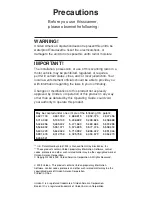
7-10
7.3.2
Other Image Options
Binarization
This
is the process of converting a grayscale or color image to a
bi-tonal image. There are several different methods of
performing this conversion.
Options: Dynamic Threshold,
Dynamic Threshold (AD), Fixed Processing, Halftone 1~5,
Error Diffusion
.
Dynamic
Threshold:
Selecting
Dynamic Threshold
allows
the scanner to dynamically evaluate each document to
determine the optimal threshold value to produce the highest
quality image. This is used to scan mixed document containing
faint text, shaded background, or color background with a single
setting. If Dynamic Threshold is selected, Threshold,
Brightness, and Contrast are not available.
Dynamic
Threshold (AD):
Selecting
Dynamic Threshold
(AD)
to perform the enhanced mode of the Dynamic Threshold
feature. However, using this mode may slow down your
scanning speed.
Sensitivity of Dynamic Threshold
Occasionally your scanned image may contain small dots or
speckles. To remove these spots, increase the sensitivity value
by moving the bar to the right. The value ranges from 1 to 30.
The default is 20.
Fixed Processing:
Used for black-and-white and other high
contrast documents. A single level is set to determine the black-
and-white transition. The threshold is programmable over the
entire density range.
Fixed Processing
sets Contrast to 0. If
Fixed Processing
is selected, Contrast is not available.
Halftone:
In addition to the black and white display, Halftone
can present a somehow gray shade of image by using different
size of dots. Halftone image looks like the picture we have seen
in the newspaper.
Options include Halftone 1, Halftone 2,
Halftone 3, Halftone 4, Halftone 5.
Error Diffusion:
Error Diffusion is a type of Halftone.
Error
Diffusion gives good image texture and makes text in images
more readable than Halftone.
Halftone Image Error Diffusion Image
















































